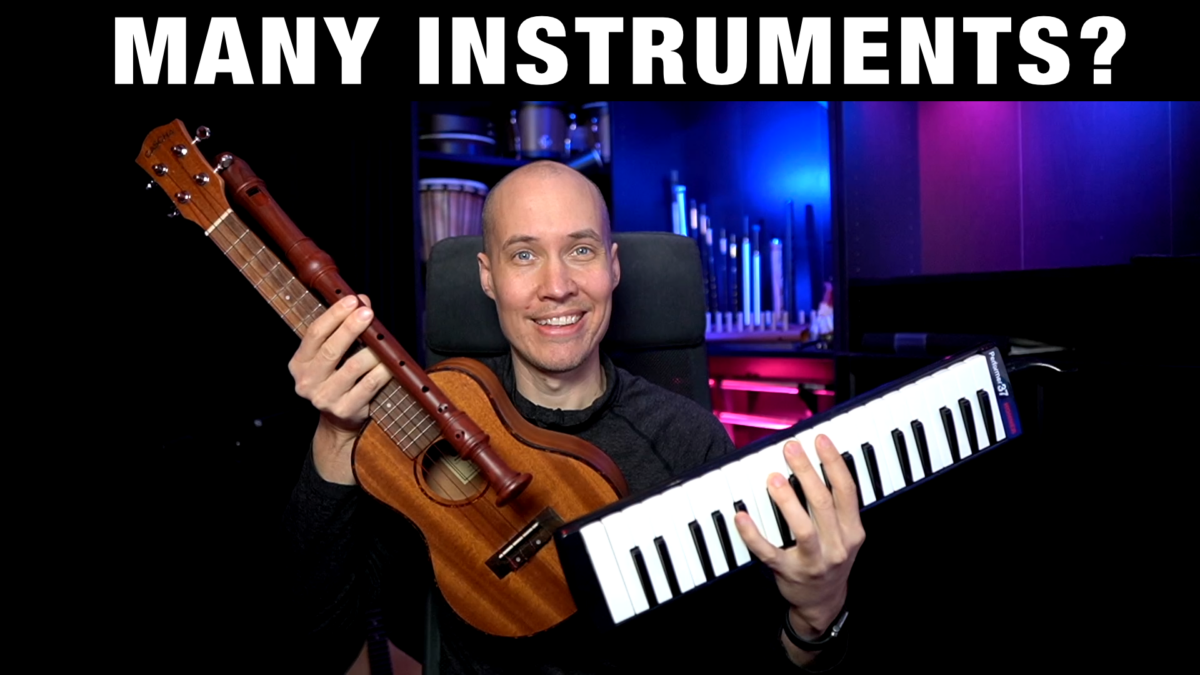 Are you dreaming about being able to play a whole range of different music instruments?
Are you dreaming about being able to play a whole range of different music instruments?
I can honestly say, that after I started my own journey towards becoming a multi-instrumentalist, I have felt so incredibly motivated and inspired. Learning to play many instruments is like a never-ending fun and exciting adventure.
But you should not simply buy 10 instruments, and start trying to learn them all at once. I have some recommendations for you:
1 – Focus on one Instrument First
I strongly advice you to start on one single instrument, and learn not only the basics, but at least to a comfortable level. When you feel you can play songs and tunes on it, and even play some tunes by ear, that’s when you can move on to the next instrument.
Which instrument should you start on? The one that you feel the most motivated to learn, and the one you love the sound of. However, I would recommend an instrument that you can play both melodies and harmonies on, because that way you will automatically be learning a bigger scope of music knowledge.
This is why my main suggestions are: Piano (keyboard), Guitar or Ukulele. Choose one.
2 – Transition to Sister Instruments
By “sister instruments” I mean that you should take the easier path of going from one instrument, to another one that is in the same family of instruments.
For example: guitar to ukulele, because both are fretted string instruments that you pluck or strum. Another example is recorder to flute, because both are wind instruments in the flute family.
Of course, if you want to be a multi-instrumentalist that can play instruments from different instrument families, you will need to eventually switch.
But to make your instrument learning journey easier, I recommend to at least begin with a sister instrument when you transition from your first to your 2nd or even 3rd instrument.
For example: if you start on guitar, you can choose another fretted string instrument next, like ukulele, banjo, mandolin, bouzouki etc.
If you start on recorder you can go to another wind instrument next, like flute, tin whistle etc.
If you start on piano, you can continue with another instrument that has a similar “keys layout”, like mallet instruments (glockenspiel, xylophone etc.).
3 – Your Muscle Memory is Key
When you are improving your skills on any music instrument, you will quickly realise that most of the technical skills you struggled with at the beginning will start to become automatic. Things like proper fretting on a guitar, sealing the holes on a flute, avoiding squeaks on a clarinet etc.
With daily practice, eventually all these things will become part of your muscle memory. And this is why it will feel so easy to pick up a “sister instrument” and start learning that one too.
However, you will exponentially improve your muscle memory if you do exercises that focus on specific technical aspects of playing your particular instrument.
This is one of the reasons you should play scales, arpeggios, etudes, and practice various phrases…all at a very slow tempo with high focus on control.
It’s also why you should have a purpose each time you practice, and focus on improving your muscle memory in that particular aspect. For example, playing guitar scales without any fret buzz. Playing a wind instrument with good intonation and a balanced tone. And so on.
4 – Ear Training is Essential
Music is about intervals, which creates melodies and harmonies in various rhythmic patterns and phrases. And they all interweave together to form the complete music composition.
Just like muscle memory, you will automatically train your ear to recognise intervals, harmonies and even chords. And you don’t have to even think about it. After a while, you will suddenly feel that you will be able to pick out the correct notes of a tune or melody on your instrument, without any sheet music or reference…playing by ear!
However, also like muscle memory, you will improve faster by doing specific exercises. Scales and arpeggios are incredible for this. But also, starting on different notes and doing interval jumps (going from one note to another).
5 – Playing over Music will Boost Motivation
Playing along when you listen to the actual song can be very motivating. It can also be a bit tricky since you will not hear your mistakes as much when the music is playing.
But the point is that it is way more fun, than practicing an instrument solo. And if somethings feels more fun and inspiring, you will do it more. And more practice = more improvement.
As long as you also do the focused practice routines (what most people find boring), and don’t skip those entirely, you will make remarkable progress on your instrument learning journey.
Instrument Family Tree
I want to give you a quick overview of some of the most common instruments in the various instrument families, so that you can find your own path more easily, meaning the progression of instruments you add on your learning journey towards becoming a multi-instrumentalist.
Plucked String Instruments
- Guitar
- Ukulele
- Mandolin
- Banjo
Wind Instruments
- Recorder
- Flute
- Tin Whistle
- Native American Flute
- Ocarina
Wind Instruments (Free Reed)
- Melodica
- Harmonica
Reed Instruments
- Saxophone
- Clarinet
- Oboe
- Bassoon
Brass Instruments
- Trumpet
- Trombone
- Horn
- Tuba
Bowed String Instruments
- Violin
- Viola
- Cello
- Double Bass

